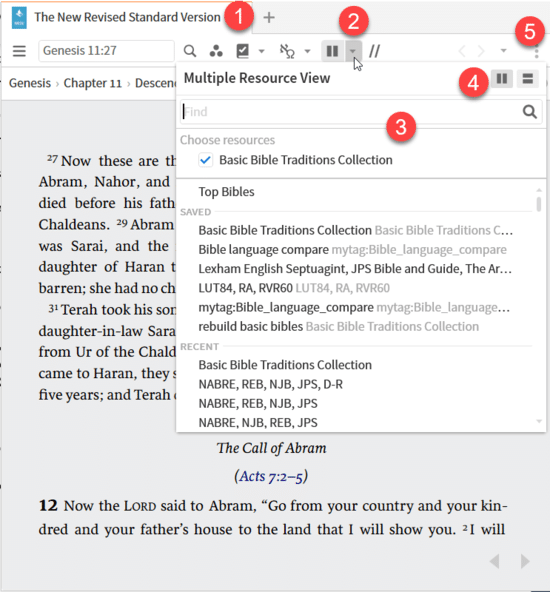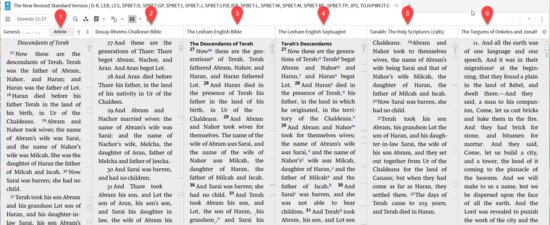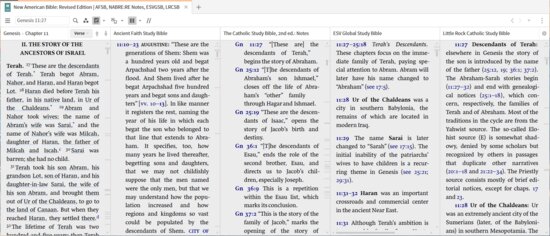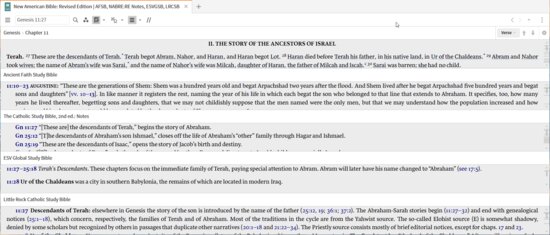Docx files for personal book: Verbum 9 part 1; Verbum 9 part 2; Verbum 9 part 3; Verbum 9 part 4; How to use the Verbum Lectionary and Missal; Verbum 8 tips 1-30; Verbum 8 tips 31-49
Reading lists: Catholic Bible Interpretation
Please be generous with your additional details, corrections, suggestions, and other feedback. This is being built in a .docx file for a PBB which will be shared periodically.
Previous post: Verbum Tip 6m Next post: Verbum Tip 6o
Multiview panel
The Multiview panel is Faithlife’s response to requests to define a driver resource in user-defined link sets.
From Verbum Help
[quote]Multiple Resources
The Multiple Resources feature provides additional "guest" resources in the same panel as the main "host" resource. This functions similarly to having multiple resource panes open connected with a link set, with some differences and advantages.
Any number of resources can be added as guests, and guest resources share several of the traits of a host resource automatically. Visual Filters, Inline Interlinears, and Inline Searches will all be applied to applicable guest resources.
Accessing the Multiple Resources feature
The feature is only accessible in resources that contain Bible milestones; in general, this means Bibles, Bible Commentaries, original language fragments, etc. Add the Multiple Resources menu to a Bible by clicking the icon on the resource toolbar. The Multiple Resources option can be enabled and disabled after adding guest resources by clicking again, or by pressing Cmd+Shift+M (Mac) / Ctrl+Shift+M (Windows).
Adding guest resources
Click to open the Multiple Resources drop-down menu. Enter a book’s full title, or short title, and matches will be promoted to the top of the list for easy access. For example, to add the New International Version (2011) as a guest resource, type New International or NIV and that Bible will appear at the top of the list.
To add the desired resource to the panel, click the checkbox next to the resource name. It will go to the upper section of the menu, which will populate with all added resources.
At the very top of the Multiple Resources menu, click the checkbox next to Show multiple resources: to enable and disable the feature while maintaining the list of desired resources. This is the same behavior as using the above keyboard shortcuts for toggling the feature.[1]

For those of us who are not fluent in Aramaic, Hebrew, Syriac, Greek and Latin, one solution to observing the differences in the textual traditions is to use translations of the critical texts – Vulgate, Septuagint, Peshitta, Masoretic, Targums, “standard”. For this I use a standard collection:
Basic Bible Traditions Collection Bibliography
- The Holy Bible, Translated from the Latin Vulgate. Bellingham, WA: Logos Bible Software, 2009.
- Harris, W. Hall, III, Elliot Ritzema, Rick Brannan, Douglas Mangum, John Dunham, Jeffrey A. Reimer, and Micah Wierenga, eds. The Lexham English Bible. Bellingham, WA: Lexham Press, 2012.
- Brannan, Rick, Ken M. Penner, Israel Loken, Michael Aubrey, and Isaiah Hoogendyk, eds. The Lexham English Septuagint. Bellingham, WA: Lexham Press, 2012.
- The Holy Bible: New Revised Standard Version. Nashville: Thomas Nelson Publishers, 1989.
- Kiraz, George A., and Andreas Juckel, eds. The Syriac Peshiṭta Bible with English Translation: Deuteronomy. Translated by Carmel McCarthy. Antioch Bible. Piscataway, NJ: Gorgias Press, 2013.
- Kiraz, George A., and Andreas Juckel, eds. The Syriac Peshiṭta Bible with English Translation: Galatians–Philemon. Translated by J. Edward Walters. Antioch Bible. Piscataway, NJ: Gorgias Press, 2013.
- Greenberg, Gillian, and Donald M. Walter. The Syriac Peshiṭta Bible with English Translation: Isaiah. Edited by George A. Kiraz and Andreas Juckel. Translated by Gillian Greenberg and Donald M. Walter. Antioch Bible. Piscataway, NJ: Gorgias Press, 2012.
- Kiraz, George A., and Andreas Juckel, eds. The Syriac Peshiṭta Bible with English Translation: Jeremiah. Translated by Gillian Greenberg and Donald M. Walter. Antioch Bible. Piscataway, NJ: Gorgias Press, 2013.
- Kiraz, George A., and Andreas Juckel, eds. The Syriac Peshiṭta Bible with English Translation: Lamentations, Prayer of Jeremiah, Epistle of Jeremiah and Epistles of Baruch. Translated by Gillian Greenberg and Donald M. Walter. Antioch Bible. Piscataway, NJ: Gorgias Press, 2013.
- Kiraz, George A., and Andreas Juckel, eds. The Syriac Peshiṭta Bible with English Translation: Luke. Translated by Jeff W. Childers. Antioch Bible. Piscataway, NJ: Gorgias Press, 2013.
- Childers, Jeff W. The Syriac Peshiṭta Bible with English Translation: Mark. Edited by George A. Kiraz and Andreas Juckel. Translated by Jeff W. Childers. Antioch Bible. Piscataway, NJ: Gorgias Press, 2012.
- Childers, Jeff W. The Syriac Peshiṭta Bible with English Translation: Matthew. Edited by George A. Kiraz and Andreas Juckel. Translated by Jeff W. Childers. Antioch Bible. Piscataway, NJ: Gorgias Press, 2012.
- Kiraz, George A., and Andreas Juckel, eds. The Syriac Peshiṭta Bible with English Translation: Romans–Corinthians. Translated by Daniel King. Antioch Bible. Piscataway, NJ: Gorgias Press, 2013.
- Kiraz, George A., and Andreas Juckel, eds. The Syriac Peshiṭta Bible with English Translation: The Twelve Prophets. Translated by Donald M. Walter and Gillian Greenberg. Antioch Bible. Piscataway, NJ: Gorgias Press, 2012.
- Jewish Publication Society. Tanakh: The Holy Scriptures. Philadelphia: Jewish Publication Society, 1985.
- Etheridge, J. W., trans. The Targums of Onkelos and Jonathan Ben Uzziel on the Pentateuch; With the Fragments of the Jerusalem Targum: From the Chaldee. London: Longman, Green, Longman, and Roberts.; Longman, Green, Longman, Roberts, and Green., 1862–1865.
Setup steps:
- Open the NRSV
- Click on the multi-view icon
- Select individual resources or collections to be driven by the NRSV.
- Choose the vertical or horizontal layout
- Select “Show locator bar” in the Panel Menu to have column titles in the vertical layout
Vertical layout:

Behavior:
- If you scroll column 1 (NRSV), then columns 2-6 will follow.
- If you scroll any of Column 2-6, only the column you scroll is affected.
An example that is useful for those leading Bible study for laity where awareness of the study Bibles participants may be using or those with comments apt to be of interest to the participants is needed..
The collection:
Catholic Study Bible Bibliography
Bell, James Stuart, ed. Ancient Faith Study Bible. Nashville, TN: Holman Bibles, 2019.
Senior, Donald, John J. Collins, and Mary Ann Getty, eds. The Catholic Study Bible, 2nd Ed.: Notes. 2nd ed. New York: Oxford University Press, 2011.
Packer, J. I., Wayne Grudem, and Ajith Fernando, eds. ESV Global Study Bible. Wheaton, IL: Crossway, 2012.
Upchurch, Catherine, Irene Nowell, and Ronald D. Witherup, eds. Little Rock Catholic Study Bible. Revised Edition. Little Rock, AR: Little Rock Scripture Study, 2011.
Unfortunately, one cannot control the sequence of the resources if you use a collection. Use must add the resources individually to do that.
Vertical format:

Horizontal format:

Remember that you can scroll all sections except the NABRE without changing any other sections.
To work in a Multiview panel, the resources must share an index but they are not required to be of the same type. An example for working through the Gospel according to John in the original Greek:

[1] Verbum Help (Bellingham, WA: Faithlife, 2018).